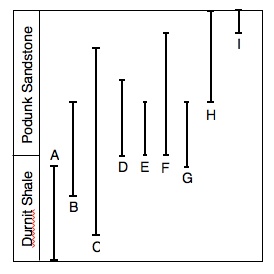Potential Final Questions
For the final, any questions from the previous quiz
guides that have not already appeared on an exam are fair game.
Short Answer:
- Explain why notions of "racial senescence" are not compatible
with current understanding of evolutionary mechanisms.
- Two paleontologists are arguing about whether the mass extinction at the
end of the Cretaceous was caused by an asteroid impact or a volcanic eruption.
They are considering this data about the fossil ranges of different ammonites
in the latest Cretaceous. Do these data (to be provided) support either or
both of the asteroid or volcanic hypothesis? Explain your reasoning.
- List and describe at least five characteristics of
a good index fossil.
- Illustrate and define each of these kinds of zones:
taxon range zone, interval zone, concurrent range zone, assemblage zone.
- Give five reasons why biostratigraphic correlations may not represent
true time correlations.
- You are a geologist doing stratigraphic studies on the Upper
Cretaceous rocks of the Western Sacramento Valley. You want to
correlate the rocks from each of the four areas you studied. You
have compiled a stratigraphic column for each of the four areas with
rock descriptions, fossil finds, and magnetic data. There is a
volcanic ash layer that appears in all four of the sections.
Describe four ways to correlate these rocks. For each of
the correlation methods, describe what we call that kind of
stratigraphy, what data is used to define units, what units are defined,
and whether that stratigraphic method will produce time correlations
(and why or why not).
- Be prepared to solve a simple gap analysis problem like the one we did in class.
- Contrast these environments with respect to
physical limiting factors (salinity, temperature, oxygen, and
substrate): fore reef, reef core, back reef. What adaptations must
organisms have in each of these zones?
Essays:
1. Explain the possible causes of the Permo-Triassic extinction in terms
of physical environment, biological environment, and catastrophe.
2. Explain the potential physical and biological effects of an asteroid or
comet impact on the earth, and discuss how well the data from the Cretaceous-Tertiary
boundary fit this model.
4. The diagram below (also available here) shows the ranges of fossils collected in the Podunk Sandstone
and Durnit Shale in the Middle-of-Nowhere Range. Fossil C was abundant everywhere
it was found; the other fossils were much rarer.
a. Devise a zonation for the Middle-of-Nowhere Range based upon these fossils
(you can draw it right on the diagram). Name each zone after one of the fossil
species found there.
b. Identify what kind of zone each of your zones is.
d. Give at least 5 reasons why the bottom of the range of species D may not
be accurate.
e. How would your zonation change if you knew that species D, E and F are benthic?
Why?

